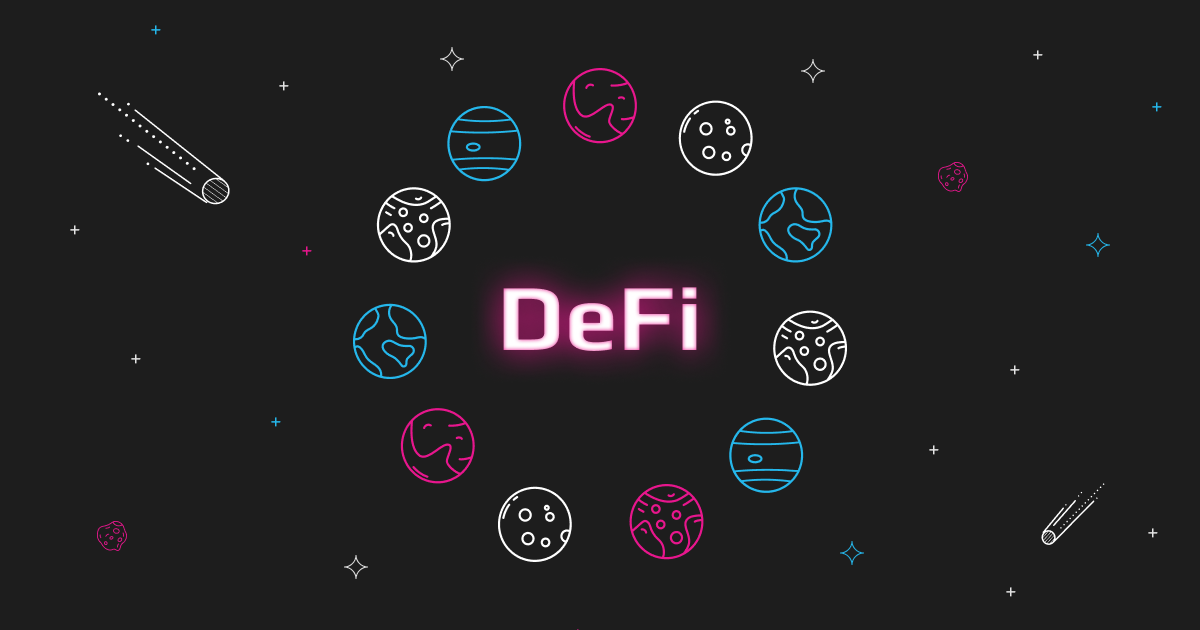We’re always on the lookout for the next big thing in the “bitcoin” world, and the DeFi protocol has recently received much attention. Decentralized Finance (DeFi) refers to a service that eliminates the need for a middleman when sending money from one location to another. So, if you’re interested in learning everything there is to know about the DeFi protocol, stick around because we’ll go over everything.
What Exactly Is DeFi?
DeFi naturally stands for Decentralized Finance. As the name implies, it’s a kind of umbrella phrase for a massive financial infrastructure that emphasizes decentralization. Decentralization, on the other hand, doesn’t appear out of nowhere; rather, it is linked to cryptocurrencies, or more specifically, the blockchain technology that underpins them. DeFi’s end goal is to decentralize financial services and replace them with decentralized organizations that allow everyone to participate.
Benefits
The DeFi movement attempts to provide customers and investors with a variety of incentives. The elimination of intermediaries, as well as centralized control, are two noteworthy benefits of DeFi. In addition, it would strive to make financial markets more accessible to institutional investors. DeFi also develops new investment options to take the concept to new heights. DeFi solutions rely heavily on the underlying characteristics associated with blockchain technology to accomplish the benefits.
Disadvantages
For effectively analyzing DeFi’s potential, it’s critical to establish a neutral sense of its benefits and drawbacks. In truth, the vast majority of issues and hazards connected with a DeFi project are essentially due to the technology involved. First, DeFi initiatives have significant challenges in the scalability of the host blockchain from a variety of angles. Finally, in DeFi-based applications and blockchain technologies, liquidity is unquestionably important, which DeFi struggles with.

DeFi Technologies: What Decentralized Finance Gives Us?
Blockchain technology, — a distributed and secure database or ledger — which is also exploited in cryptocurrencies is used in decentralized finance. dApps are the applications that conduct transactions and run the blockchain, and the transactions are stored in blocks on the blockchain and subsequently validated by other users. If all of the validators agree on a transaction, the block is sealed and encrypted, and a new block is created containing information from the preceding block.
Decentralized Exchanges
A decentralized exchange, or DEX, is a cryptocurrency exchange that works without the use of a central authority. Assume you download a DEX app on your phone and make a little Bitcoin buy. Your trade is then securely kept on a shared, tamper-proof digital ledger. The DEX, which is a decentralized peer-to-peer network, records each of these sorts of transactions. Coins can be purchased from other users on the same platform. Keep your items and take part in swapping and staking. All of this can be done simply from your phone.
Non-Fungible Tokens (NFTs) And Decentralized Finance (DeFi)
With NFTs’ ability to reflect the commercialization of digital products and services, the NFT-decentralized finance combo becomes instantaneously possible. NFTs have emerged as one of the most promising DeFi applications, with ERC-20 tokens, for example, established by Ethereum to provide value for digital assets. As a result, NFTs might easily serve as proof of digital art ownership rights. Ethereum has quickly become one of the most popular platforms for artists to showcase their work and interact with a vibrant community of collectors. NFTs could further provide remarkable value advantages in the realm of DeFi due to their flexibility in demonstrating ownership.
Centralized Finance (CeFi) vs Decentralized Finance (DeFi)
Centralized Finance platforms were among the first in the market to provide cryptocurrency trading services. All transactions in a centralized entity are conducted through a central exchange. That is, a single central exchange is in charge of all funds. You do not own a private key that provides you access to your wallet if you use the CeFi platform. DeFi, on the other hand, does not necessitate the use of a middleman (a centralized business) in order to provide crypto trading services. A decentralized exchange (DEX) is peer-to-peer, which means it links buyers and sellers directly without the use of a third-party intermediary like a bank. On a DeFi exchange, all processes are automatically organized, managed, and handled by smart contracts built on the blockchain.
Will DeFi Put Banks Out Of Business?
Banks are now attempting to enter the DeFi industry by providing crypto services to their customers. And it appears like they are working on a Frankenstein’s monster. Because they know people will eventually migrate entirely toward blockchain, they are doing everything they can to get their money using other means. In other words, DeFi will definitely, in a few years, put banks out of business unless they learn to adapt to the new changes.

Major Players: Exploring DeFi Projects
As the market turns to blockchain and DeFi protocols, several projects appear every day. Here are a few notable projects that use DeFi technology.
Ethereum DeFi
Ethereum is at the heart of the great majority of DeFi projects on the market. Other blockchains are currently viable for such activities; for example, while understanding what is Dezentralized Finance (DeFi), you may come across projects established on other platforms. Despite this, Ethereum continues to be the clear leader.
Solana DeFi
With over 423 projects now established on the platform, some of which are fundamental DeFi initiatives for the future, the Solana ecosystem is likewise expanding in its own right. For example, the move of projects like the FTX exchange and the USDC stablecoin to the Solana blockchain, as well as the introduction of NFTs on Solana, which can offer substantially lower minting and trading fees, are all part of the blockchain.
Cardano DeFi
Cardano is a system that generates rapid, flexible, and long-term growth. This enables every Cardano project to be both inexpensive and fast, as well as to grow without any issues. Unlike ETH, where people have issues with fees, or BSC, where people have issues with centralization. Cardano’s blockchain provides one of the greatest foundations for any project creators, from finance dApps to gaming to many other applications.
Polygon DeFi
Polygon was previously known as Matic Network, and it is a blockchain layer 2 scalability solution. Blockchain of Polygon aims to solve all of the problems of the ETH blockchain and any other chain that may have the same problem, given how tough and expensive it is to be in the ETH realm. You may use a multi-chain blockchain with Polygon, which allows for faster and cheaper transactions all around.
Avalanche DeFi
Avalanche is a decentralized application and financial primitives platform that is open-source. Its creators hope to guide the industry toward decentralized finance and lay new groundwork for the industry. Avalanche uses a heterogeneous network with many validator sets and blockchains to provide the same level of security as Ethereum or Bitcoin in a shorter amount of time.
Llama DeFi
DeFi Llama is a renowned internet resource providing comprehensive information on numerous DeFi products. For example, Llama DeFi provides data on DeFi cryptocurrencies’ current price levels, as well as TVL data for DEXs (decentralized exchanges), lending protocols, yield farming activities, staking pools, DeFi insurance, and a variety of other DeFi goods.
SushiSwap DeFi
SushiSwap was described as an “evolution of Uniswap” that included “community-oriented features” to benefit the participants — especially a token. While trading fees are split among LPs in Uniswap, trading fees and SUSHI tokens are dispersed to LPs in SushiSwap. A percentage of the fees is also converted back to SUSHI and delivered to SUSHI token holders, allowing them to continue receiving a share of the protocol’s fees even if an LP stops providing liquidity. SUSHI is also required to take part in protocol governance.
Aave DeFi
Aave is a decentralized money market service that allows users to borrow cryptocurrencies safely and securely, with variable and steady interest rates. The Aave project is quickly establishing itself as a market leader in the DeFi lending and borrowing industry. This is because, unlike other protocols that deal with KYC and require long registrations, Aave frees users from all of these restrictions.
Cake DeFi
Cake DeFi is a platform that connects the Bitcoin ecosystem to financial services. This DeFi project allows BTC cryptocurrency holders to enjoy the features traditionally associated with DeFi apps on Ethereum, Bitcoin’s main rival blockchain (ETH).
Bitcoin And DeFi
Although a veteran in the space, and a not-so-easy-to-scale project, Bitcoin can be used in DeFi products in two different ways. The first is to employ a wrapped version of Bitcoin in a foreign blockchain, while the second is to create native smart contracts on BTC.

Is Decentralized Finance (DeFi) The Future?
The evolution of Decentralized Finance is still in its early phases. However, the Decentralized Finance (DeFi) movement appears to have reached early adopter status, and the following years will reveal whether it succeeds in crossing the divide into general usage. There’s no denying that a decentralized financial system can help a large segment of the population who are currently subjected to financial discrimination, excessive fees, and inefficient money management.
How To Invest In DeFi?
You can quickly make your first DeFi investment by buying some crypto on Swapzone by utilizing one of the many instant cryptocurrency exchange companies provided. These supported offers and exchange rates can all be reviewed on the page. Read their KYC/AML procedures and community evaluations to avoid issues. When performing crypto-to-crypto transactions, make sure to account for costs. Let’s say you want to buy BTC with ETH. The following are the steps to purchasing BTC or any other coin on Swapzone:
- Go to Swapzone.io for more information.
- In the “Send” area, choose Bitcoin (BTC).
- Fill in the amount you’d like to swap.
- In the “Get Up To” section, select cryptocurrency.
- Examine the various offerings and the companies that provide them.
- To continue, choose a request.
- To receive cryptocurrency, enter your wallet address.
- Make a BTC deposit to an address that has been generated.
- Give your exchange provider a rating.


